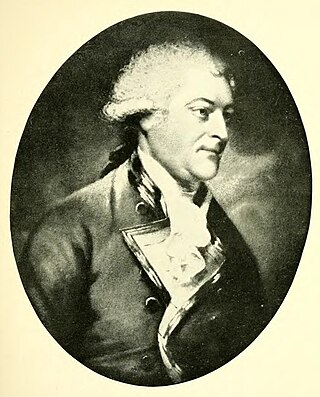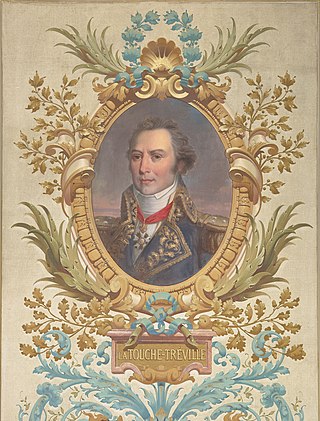
The second battle of Cape Finisterre was a naval encounter fought during the War of the Austrian Succession on 25 October 1747 (N.S.). A British fleet of fourteen ships of the line commanded by Rear-Admiral Edward Hawke intercepted a French convoy of 250 merchant ships, sailing from the Basque Roads in western France to the West Indies and protected by eight ships of the line commanded by Vice Admiral Henri-François des Herbiers.

The Battle of Cape Passaro, also known as Battle of Avola or Battle of Syracuse, was a major naval battle fought on 11 August 1718 between a fleet of the British Royal Navy under Admiral Sir George Byng and a fleet of the Spanish Navy under Rear-Admiral Antonio de Gaztañeta. It was fought off Cape Passaro, in the southern tip of the island of Sicily of which Spain had occupied. Spain and Britain were at peace, but Britain was already committed to supporting the ambitions of the Emperor Charles VI in southern Italy.
John Elliot was a Scottish officer of the Royal Navy who served during the Seven Years' War and the American War of Independence. He rose to the rank of admiral, and served briefly as colonial governor of Newfoundland.

Sir Nathaniel Dance was an officer of the East India Company who had a long and varied career on merchant vessels, making numerous voyages to India and back with the fleets of East Indiamen. He was already aware of the risks of the valuable ships he sailed on being preyed on by foreign navies, having been captured by a Franco-Spanish fleet in 1780 during the East Indies campaign of the American War of Independence. His greatest achievement came during the Napoleonic Wars, when having been appointed commodore of one of the company's fleets, he came across a French squadron under Rear-Admiral Comte de Linois, which was raiding British shipping in the area.

Vice-Admiral Sir Joshua Rowley, 1st Baronet was a Royal Navy officer who was the fourth son of Admiral Sir William Rowley. Sir Joshua was from an ancient English family, originating in Staffordshire (England) and was born on 1 May 1734. Rowley served with distinction in a number of battles throughout his career and was highly praised by his contemporaries. Unfortunately whilst his career was often active he did not have the opportunity to command any significant engagements and always followed rather than led. His achievements have therefore been eclipsed by his contemporaries such as Keppel, Hawke, Howe and Rodney. Rowley however remains one of the stalwart commanders of the wooden walls that kept Britain safe for so long.

Fénix was an 80-gun ship of the line (navio) of the Spanish Navy, built by Pedro de Torres at Havana in accordance with the system laid down by Antonio Gaztaneta launched in 1749. In 1759, she was sent to bring the new king, Carlos III, from Naples to Barcelona. When Spain entered the American Revolutionary War in June 1779, Fénix set sail for the English Channel where she was to join a Franco-Spanish fleet of more than 60 ships of the line under Lieutenant General Luis de Córdova y Córdova. The Armada of 1779 was an invasion force of 40,000 troops with orders to capture the British naval base at Portsmouth.
HMS Greenwich was a 50-gun fourth rate ship of the line of the Royal Navy. She was built during the War of the Austrian Succession, and went on to see action in the Seven Years' War, during which she was captured by the French and taken into their service under the same name. She was wrecked shortly afterwards.

HMS Argo was a 44-gun fifth-rate Roebuck-class ship of the Royal Navy. She was launched in 1781 from Howdon Dock. The French captured her in 1783, but 36 hours later the British recaptured her. She then distinguished herself in the French Revolutionary Wars by capturing several prizes, though she did not participate in any major actions. She also served in the Napoleonic Wars. She was sold in 1816.

The Battle of Cap-Français was a naval engagement during the Seven Years' War fought between French and British forces outside the harbour of Cap-Français, Saint-Domingue on 21 October 1757.

The action of 8 January 1780 was a naval encounter off Cape Finisterre between a British Royal Naval fleet under Admiral Sir George Rodney, and a fleet of Spanish merchants sailing in convoy with seven warships of the Caracas Company, under the command of Commodore Don Juan Augustin de Yardi. During the action the entire Spanish convoy was captured. Rodney's fleet was en route to relieve Gibraltar, and this action took place several days before Rodney's engagement and defeat of a Spanish fleet at the Battle of Cape St. Vincent.

The voyage of the Glorioso involved four naval engagements fought in 1747 during the War of the Austrian Succession between the Spanish 70-gun ship of the line Glorioso and several British squadrons of ships of the line and frigates which tried to capture it. The Glorioso, carrying four million silver dollars from the Americas, was able to repel two British attacks off the Azores and Cape Finisterre, landing her cargo at the port of Corcubión, Spain.

The Third Battle of Ushant or the action of 20–21 April 1782 was a naval battle fought during the American Revolutionary War, between a French naval fleet of three ships of the line protecting a convoy and two British Royal naval ships of the line off Ushant, a French island at the mouth of the English Channel off the northwesternmost point of France. This was the third battle that occurred in this region during the course of the war.

The action of 7 April 1800 was a minor naval engagement fought between a British squadron blockading the Spanish naval base of Cádiz and a convoy of 13 Spanish merchant vessels escorted by three frigates, bound for the Spanish colonies in the Americas. The blockade squadron consisted of the ships of the line HMS Leviathan and HMS Swiftsure and the frigate HMS Emerald, commanded by Rear-Admiral John Thomas Duckworth on Leviathan. The Spanish convoy sailed from Cádiz on 3 April 1800 and encountered Duckworth's squadron two days later. The Spanish attempted to escape; Emerald succeeded in capturing one ship early on 6 April. The British captured a brig the following morning and the British squadron divided in pursuit of the remainder.

Admiral Robert Linzee was an officer of the Royal Navy who served during the American War of Independence, and the French Revolutionary and Napoleonic Wars.

Charles-Auguste Levassor de La Touche-Tréville (1712–1788) was a French Navy officer.
The action of 5 September 1782 took place during the American War of Independence between two French Navy frigates, Aigle and Gloire, and a lone British 74-gun ship of the line HMS Hector. In a two-day battle, the two frigates severely damaged Hector and failed to capture her only when a British squadron appeared on the horizon. The French withdrew, but Hector foundered a few days later after the 1782 Central Atlantic hurricane.

Vice-Admiral Thomas Cotes was a Royal Navy officer who became Commander-in-Chief of the Jamaica Station.
The Battle of the Levant Convoy was a naval engagement of the French Revolutionary Wars fought on 7 October 1795. During the battle, a powerful French squadron surprised a valuable British convoy from the Levant off Cape St Vincent on the coast of Portugal. The convoy was weakly defended, and although the small escort squadron tried to drive the French back, they were outmatched. In the ensuing action one of the British ships of the line and almost the entire convoy was overrun and captured. The French commander, Commodore Joseph de Richery, then retired to the neutral Spanish port of Cádiz, where he came under blockade.

Rear-Admiral Sir Thomas Hardy was a Royal Navy officer of the late 17th and early 18th centuries. Having joined the navy sometime before 1688, Hardy's career was supported by Captain George Churchill, whom he served as first lieutenant during the Battle of Barfleur in 1692. Promoted to captain in 1693, Hardy served in the Channel Islands and off the coast of England until 1702 when he was given command of HMS Pembroke off the coast of Spain. He fought at the Battle of Cádiz, and subsequently discovered the location of the Franco-Spanish fleet through the intervention of his chaplain, which resulted in the Battle of Vigo Bay. Hardy was knighted for his services.
Rear-Admiral Polycarpus Taylor was a Royal Navy officer of the eighteenth century, most notable for his service commanding ships in the West Indies during the War of the Austrian Succession. Having joined the Royal Navy some time before 1733, Taylor then served at the Battle of Cartagena de Indias and Invasion of Cuba before being promoted to commander in 1742. After commanding several vessels and being promoted to post-captain, in August 1744 Taylor took command of HMS Fowey; serving in the English Channel he ran ashore and destroyed the French privateer Griffon in 1745.















